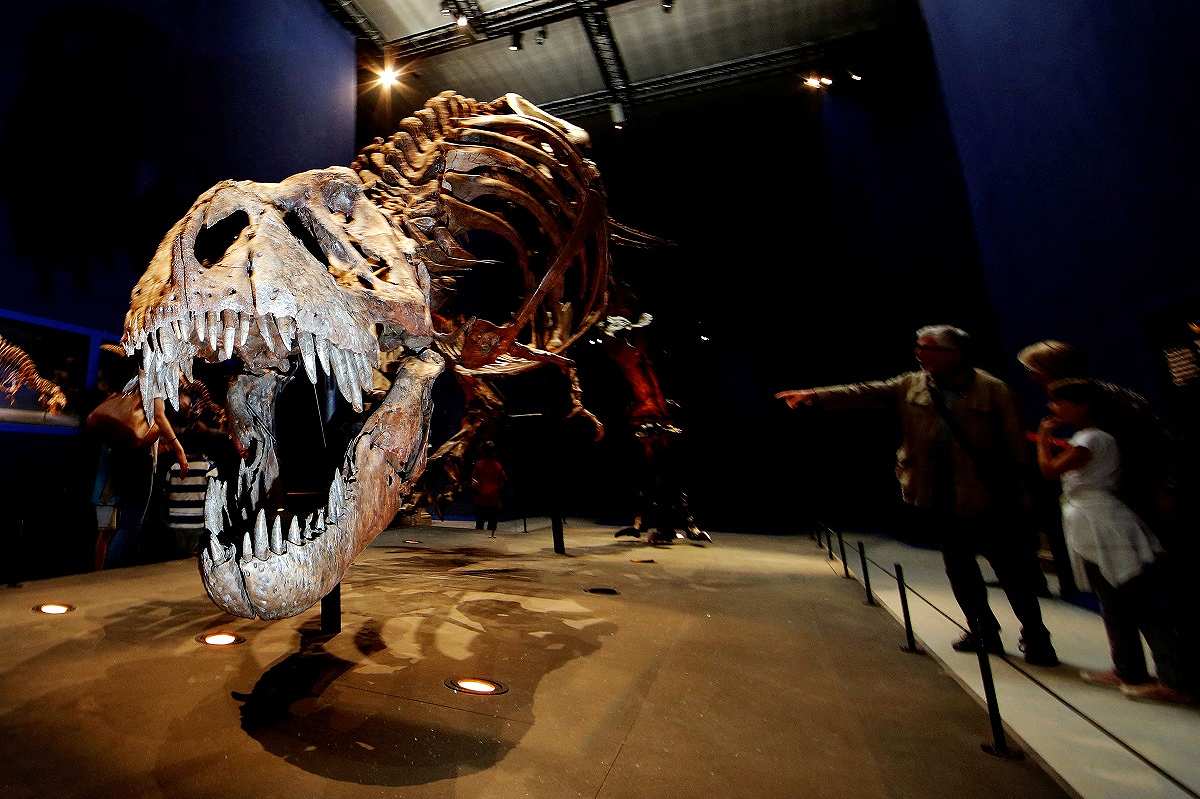
Visitors look at a 67-million-year-old skeleton of a Tyrannosaurus rex, named Trix, at the French National Museum of Natural History in Paris in June 2018.
17:15 JST, May 16, 2024
WASHINGTON (Reuters) — Surmising even the physical appearance of a dinosaur — or any extinct animal — based on its fossils is a tricky proposition, with so many uncertainties involved. Assessing a dinosaur’s intelligence, considering the innumerable factors contributing to that trait, is exponentially more difficult.
A study published last year by Vanderbilt University neuroscientist Suzana Herculano-Houzel that evaluated the intelligence of Tyrannosaurus rex, focusing upon estimated brain size and the number of brain neurons, as comparable to that of primates — specifically a baboon — caused a stir in scientific circles.
Now, an interdisciplinary scientific team has published a study in rebuttal, questioning Herculano-Houzel’s methodology and challenging her appraisal of the smarts of T. rex and other big dinosaur predators in the dinosaur clade called theropods.
They instead suggested a more holistic approach to assess the braininess of Tyrannosaurus or any extinct animal, with brain size and neuronal count considered alongside other factors such as an animal’s anatomy and ecology, data from living relatives and fossil evidence about how it moved about and fed that offer insight into its life.
“Our key findings are that the brains of most dinosaurs, including T. rex, were comparable in relative size to those of living reptiles, such as crocodiles and alligators. Furthermore, their neuron numbers were likely not exceptional, especially for animals of their body mass,” said zoologist Kai Caspar of Heinrich Heine University in Germany, who studies the behavior of living animals and was the lead author of the study published last month in the journal The Anatomical Record.
“What needs to be emphasized is that reptiles are certainly not as dim-witted as is commonly believed,” Caspar added. “Their behaviors can be very complex, and the experimental data we have point to many cognitive similarities between them, mammals and birds. So whereas there is no reason to assume that T. rex had primate-like habits, it was certainly a behaviorally sophisticated animal.”
Herculano-Houzel said she stands by her findings and called the new analysis flawed.
“The only thing that is under dispute is what already was at the time of my study: what was actually the size of dinosaur brains. Even then, we’re talking about the difference between a T. rex brain being baboon- or monkey-sized,” Herculano-Houzel said.
“Their conclusion hinges on a single extremely important point: whether theropods like T. rex shared their [brain-to-body size] relationship with their extant warm-blooded ostrich and chicken cousins, or with their more distant living relatives, crocodiles. I said the former, because I compared theropods to ostriches and chickens; they now say the latter,” Herculano-Houzel added.
Caspar said the comparison to modern birds also was an integral part of the new study.
‘Not a trivial question’
There are problems in trying to gauge intelligence from brain neuron count, Caspar said.
“The first obstacle is to estimate the actual size of the brain of the extinct animal in question. This is not a trivial question in dinosaurs. While the brain fills almost the entire skull cavity in birds and us mammals, this is not the case for reptile species, the brain of which fills only about 30%-50% of the skull cavity,” Caspar said.
“The 2023 study assumed a 100% fill in dinosaurs such as T. rex, and that was certainly not the case,” Caspar added.
It is unknown how densely packed the neurons were in dinosaur brains, Caspar said.
“However, looking at living animals, we see that neuron counts are actually not a good indicator of intelligence in the first place, although that might appear intuitive at first glance,” Caspar added.
The dinosaurs, aside from their bird descendants, disappeared 66 million years ago after an asteroid struck Earth. In two centuries of scientific study, dinosaurs are coming into better focus, though plenty of uncertainties remain about Tyrannosaurus and the others.
“Given the brain size we found for it, Tyrannosaurus probably occupied a level of intelligence we don’t see in the modern world: more intelligent than crocodilians, but less intelligent than typical living birds and mammals,” said University of Maryland paleontologist Thomas Holtz, a coauthor of the new study.
“Intelligence is one of the most difficult things to measure even in modern animals, and many of our common assumptions don’t really hold up when you actually examine what real animals do in the real world,” Holtz said.
“So when we try to estimate the intelligence and cognition of ancient animals, we are going to have some difficulties. It would be nice if we could just estimate one number and unravel the whole complexity of an animal’s biology and lifestyle, but nature isn’t like that.”
"Science & Nature" POPULAR ARTICLE
-

Genome Study Reveals Milestone in History of Cat Domestication
-

Big Leap in Quest to Get to Bottom of Climate Ice Mystery
-

Security Camera Footage Vulnerable to Outside Access; Investigation Finds 3,000 Pieces Exposed Online
-

Paws on Parade: Nairobi’s Dogs Dazzle at ‘Pawchella’
-

Japanese Eels Escape New Regulation in Vote at CITES Meeting, Avoiding Higher Prices for Dealers and Diners
JN ACCESS RANKING
-

Keidanren Chairman Yoshinobu Tsutsui Visits Kashiwazaki-Kariwa Nuclear Power Plant; Inspects New Emergency Safety System
-

Imports of Rare Earths from China Facing Delays, May Be Caused by Deterioration of Japan-China Relations
-

University of Tokyo Professor Discusses Japanese Economic Security in Interview Ahead of Forum
-

Japan Pulls out of Vietnam Nuclear Project, Complicating Hanoi’s Power Plans
-

Govt Aims to Expand NISA Program Lineup, Abolish Age Restriction
























